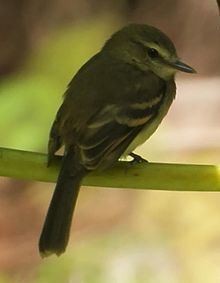Scientific name Cnemotriccus fuscatus Higher classification Cnemotriccus Order Passerine | Family Tyrannidae Phylum Chordata Rank Species | |
 | ||
Genus CnemotriccusHellmayr, 1927 Similar Yellow tyrannulet, Euler's flycatcher, Greenish tyrannulet, Spotted tody‑flycatcher, Shear‑tailed grey tyrant | ||
Fuscous flycatcher
The fuscous flycatcher (Cnemotriccus fuscatus) is a small passerine bird in the tyrant flycatcher family, and the only member of the genus Cnemotriccus. It breeds from Colombia and Venezuela south to Bolivia, Paraguay and Argentina, and on both Trinidad and Tobago. The fuscous flycatcher ranges in northern and eastern South America, including the entire Amazon Basin, and the Guianas; also all of Brazil except the very southeastern border area with Uruguay.
Contents
This species is found in woodland and scrubby areas. The nest is made of twigs and bark lined with plant fibre and placed in a tree fork. The typical clutch is three white eggs, which are marked with black at the larger end.
The fuscous flycatcher is 14.5 cm long and weighs 11.9g, with a long tail. The upperparts are plain brown with darker brown wings and two buff wing bars. There is an obvious long whitish supercilium, and the bill is black. The breast is grey-brown and the abdomen is pale yellow. Sexes are similar. There are other races, differing in the tone of the upperpart or underpart colour.
Fuscous flycatchers are inconspicuous birds, tending to keep to undergrowth perches from which they sally forth to catch insects, (hawking). The call is a light chip, and the song a chip-weeti-weeti-weetiyee, replaced in southern races by an explosive version at dawn, pit-pit-peedit.
